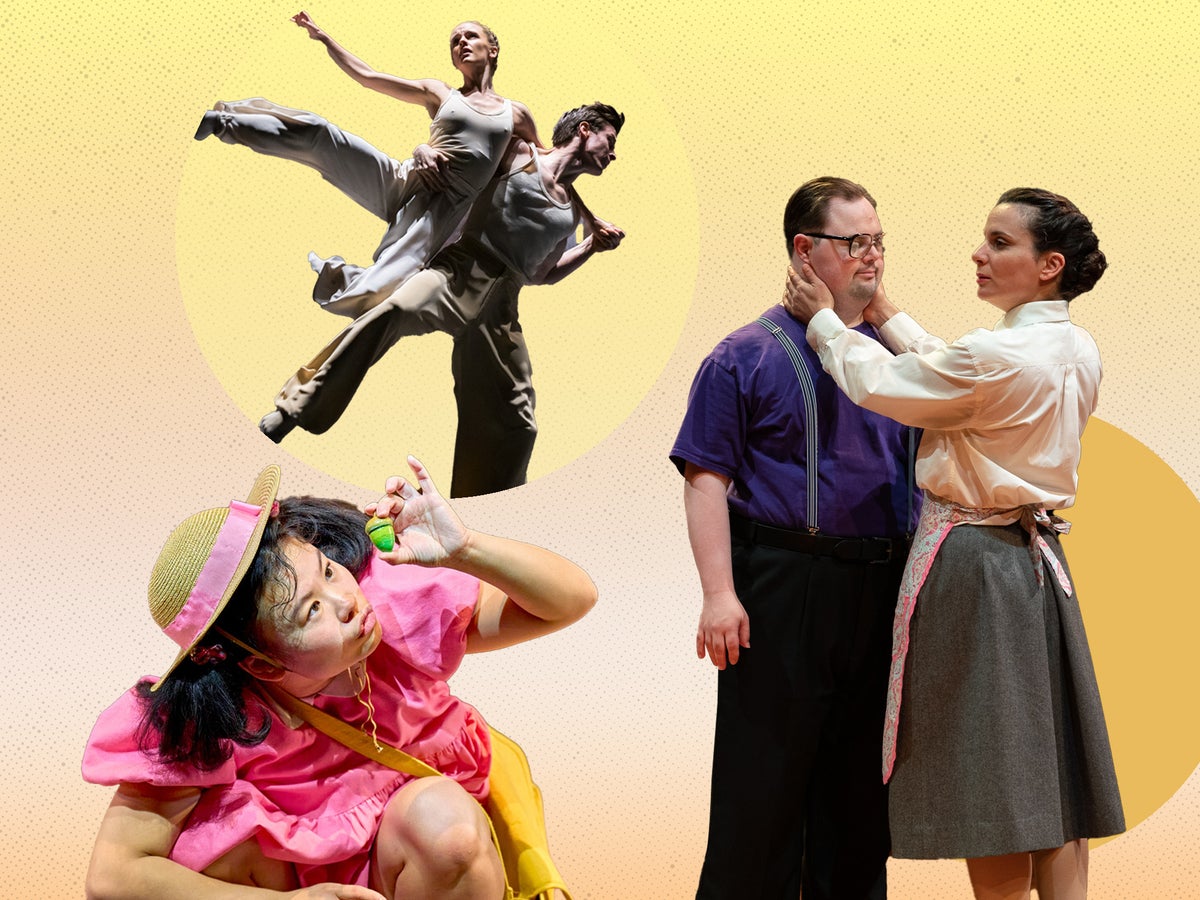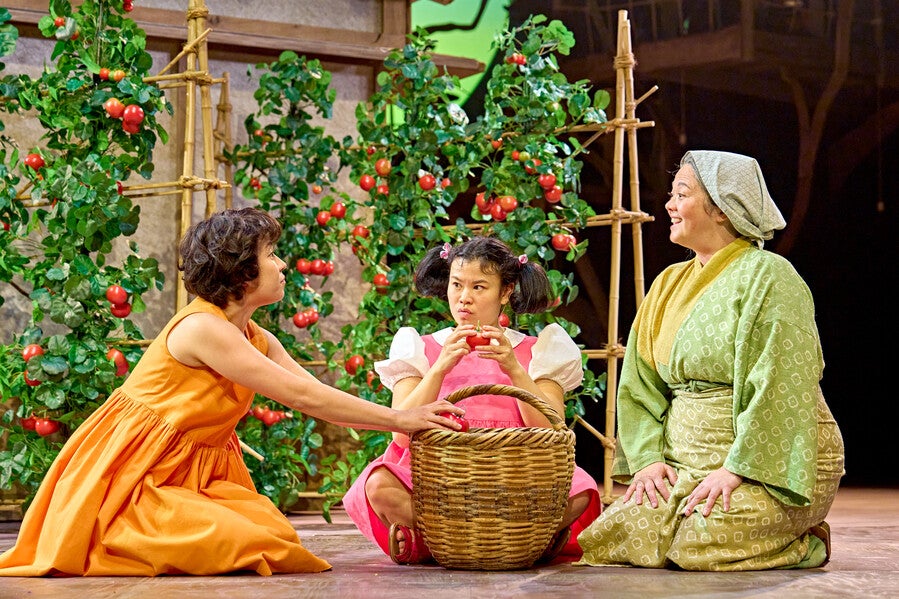
This week, Studio Ghibli meets the Royal Shakespeare Company, Crystal Pite choreographs a full-length work for the Royal Ballet, and a new theatre opens in the West End.
My Neighbour Totoro – Barbican ★★★★☆
First, a warning: you will leave the Royal Shakespeare Company’s stage adaptation of My Neighbour Totoro with sore cheeks. But that’s a small price to pay for the two and a half hours you’ll spend grinning from ear to ear – something all but guaranteed with this fantastical and unlikely production of a Studio Ghibli favourite.
Initially, any attempt to bring to life the much-adored 1988 film – about two young girls who move to the countryside with their father and encounter a mystical realm – seems improbable. How do you summon Hayao Miyazaki’s adorable, pot-bellied, long-whiskered 7ft-tall titular creature? It turns out the Royal Shakespeare Company had the answer all along: puppets! Courtesy of celebrated American puppeteer Basil Twist, Miyazaki’s farm animals and mischievous soot sprites materialise as if by magic. Catbus and Totoro are here, too. Such is the visual spectacle that the music, composed by Joe Hisaishi (also behind the film score) and sung by Ai Ninomiya, can sometimes be overwhelmed by the splendour of the visual storytelling.

As sisters Satsuki and Mei, adult actors Ami Okumura Jones and Mei Mac are cartoonish but necessarily so. Jones and Mac play their roles with childhood glee, every movement big and exaggerated. Blur your eyes a little and as they run about, arms flailing behind them, they look almost identical to their animated counterparts. The set (designed by Tom Pye) unfurls itself like origami, folding and unfolding endlessly to reveal a tiny classroom, or a sprawling rice field, or an enchanted woodland. It’ll be hard to find a Studio Ghibli fan unimpressed with My Neighbour Totoro – and for those unfamiliar with Miyazaki’s cartoon world, this stage adaptation welcomes you with open, fluffy arms. Annabel Nugent
Light of Passage – Royal Opera House ★★★★☆
Choreographer Crystal Pite can make dancers move like a murmuration of starlings, motion pulsing and rippling through a group of bodies. In Light of Passage, her new work for the Royal Ballet, those big blocks of movement evoke a community or a whole human society, from cradle to grave.
One of the world’s most in-demand choreographers, the Canadian Pite is known both for her sharp works with speech and for her gift with massed movement. In both, she has a political edge, a concern for how people treat each other. Light of Passage expands Flight Pattern, which Pite created for this company in 2017. A response to the refugee crisis, the earlier work used the first movement of Henryk Górecki’s Symphony of Sorrowful Songs. Now she stages the whole symphony, adding two new works.

Flight Pattern sets the tone for the evening-length work, and remains the most intense. Dancers rock and flow together, making a perilous journey. Movement goes from naturalistic to stylised and back again, as a coat is cradled like a child or heaped into someone else’s arms. Kristen McNally and Marcelino Sambé are haunting in solo roles. For the two new works, Jay Gower Taylor’s set, lit by Tom Visser, conjures up smoke and reflections. Patterns hang in the air, like a blown glass sculpture looming over the dancers’ heads. As the mood shifts, the reflections flare into apocalyptic red or glowing white and gold.
In a series of four duets, couples reach for calm, but it’s the moments of strain that stand out: a woman embracing a man who vanishes from her grasp, a shiver of tension or loneliness. The whole company dance with wholehearted conviction, diving into Pite’s fluid and churning moves. Zoë Anderson
Marvellous – @sohoplace ★★☆☆☆
You’ll struggle to find a man with a more compelling story than Neil Baldwin. Born in 1946 and diagnosed with learning difficulties as a child, Baldwin’s life has been colourful: he was a clown, a kit man and occasional player for Stoke City, and was even named in the 2019 new year honours. Along the way, he befriended royalty (Prince Edward), the clergy (the archbishop of Canterbury), sporting legends (Gary Lineker) and, most importantly, magician’s assistants (Debbie McGee).
In 2014, Baldwin’s story was told in Marvellous, a Bafta-winning BBC TV series starring Toby Jones. Fast forward eight years and a play of the same name, co-written by Baldwin himself, is opening at @sohoplace, the much-hyped, terribly named swish new theatre in the West End. There’s a wealth of comic talent on display among the cast (which includes a number of neurodivergent actors) but the play itself never manages to live up to their potential or Baldwin’s story. For such an interesting man, this production feels like a slog.

Here, Michael Hugo plays the role of our narrator, the “Real Neil”. Initially, he sits among the audience but soon springs onto the stage, directing the action and joining in himself as the ensemble act out his life. Hugo is an outstanding comic actor and the force controlling this largely incoherent production. You can’t help feeling that Baldwin’s story, stripped back to a one-man show, would make a great hour-long fringe theatre show. At over two hours, however, the script lags and audience attention wanders.
Marvellous gets going in the second act but only when the cast are given room to roam. A hilarious, Play That Goes Wrong-esque slapstick sequence gets the biggest laughs of the evening and comes with a warning for anyone with a “pantomime intolerance”. Unfortunately, it’s immediately followed by two minutes in which the cast clean the stage, during which my eyelids felt particularly heavy. Baldwin’s story could make a great play – but this isn’t it. Isobel Lewis







